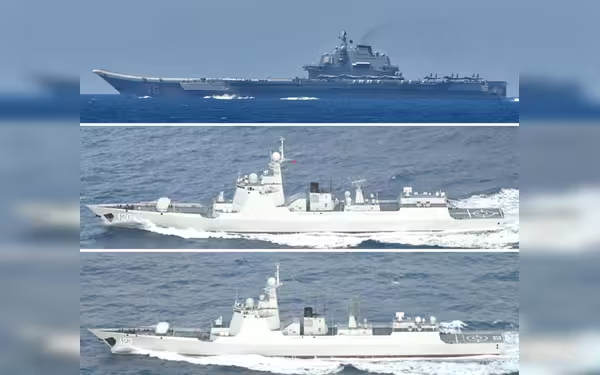Saturday, November 16, 2024 10:32 PM
Chinese Navy Flotilla Navigates Between Japanese Islands Near Taiwan
- Chinese aircraft carrier sails near Japanese islands.
- Japan raises concerns over China's naval assertiveness.
- Taiwan reports increased military presence in Asia-Pacific.
 Image Credits: arabnewspk
Image Credits: arabnewspkChinese aircraft carrier Liaoning sails between Japanese islands, raising regional security concerns amid rising military assertiveness.
The recent movements of the Chinese navy have raised eyebrows across the Asia-Pacific region, particularly with the passage of a Chinese aircraft carrier between two Japanese islands near Taiwan. This event marks a significant moment in the ongoing tensions between China and Japan, as well as the broader implications for regional security.
On a Tuesday to Wednesday passage, the Chinese aircraft carrier Liaoning, accompanied by two Luyang III-class missile destroyers, was observed sailing southward between the islands of Yonaguni and Iriomote. This is the first time that a Chinese aircraft carrier has been confirmed to navigate these waters, which are situated near a group of uninhabited islands that have long been a point of contention between Japan and China.
According to Japan's defense ministry, the presence of the Liaoning in these waters is particularly noteworthy as it signifies a potential shift in China's naval operations. The ministry stated, "This is the first time that an aircraft carrier belonging to the Chinese Navy has been confirmed to have sailed through the waters between Yonaguni and Iriomote." This development has not gone unnoticed, with public broadcaster NHK and other media outlets reporting that this is the first instance of a Chinese aircraft carrier entering Japan's contiguous waters.
Contiguous waters extend 12 nautical miles beyond a country's territorial waters, where nations can exert some control according to international maritime law. The implications of this passage are significant, as it reflects China's growing military assertiveness in the region, which has been a source of concern for the United States and its allies.
In a related development, Taiwan's government reported that the Liaoning-led naval formation sailed through waters northeast of Taiwan before continuing towards Japan's Yonaguni Island. This maneuver is part of a broader pattern of China's increasing military presence in the Asia-Pacific, which has included tense encounters with Japanese and Chinese vessels in disputed areas, particularly around the Senkaku Islands in the East China Sea.
Japan has been on high alert, having scrambled fighter jets in response to previous incursions by Chinese military aircraft into its airspace, which Tokyo labeled as a "serious violation" of its sovereignty. In light of these developments, Japan is ramping up its defense spending, encouraged by the United States, and is moving towards acquiring counter-strike capabilities while easing restrictions on arms exports.
Furthermore, Japan has been actively engaging with other countries in the region, providing funding and equipment such as patrol vessels. A recent agreement with the Philippines allows for troop deployments on each other's soil, highlighting the growing military cooperation among nations concerned about China's assertiveness.
In addition to these tensions, Japan has also been monitoring Russian military activities, including joint drills conducted by Russian and Chinese warships in the Sea of Japan. This month, Japan observed five Chinese naval ships entering the Sea of Japan, likely en route to these joint maneuvers, which President Vladimir Putin described as the largest naval exercise in three decades.
As the geopolitical landscape continues to evolve, the actions of the Chinese navy serve as a reminder of the delicate balance of power in the Asia-Pacific region. The increasing military presence of China, coupled with Japan's response to bolster its defense capabilities, underscores the complexities of international relations in this area. It remains to be seen how these developments will shape the future of security and cooperation among nations in the region.













